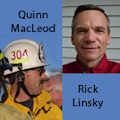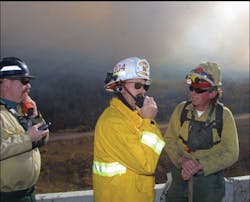Communicating in the Wildland Urban Interface
Communicating during emergency operations is a constant challenge for those in the fire service. Nowhere does that become more evident than during a wildland urban interface (WUI) incident. Structural firefighters who find themselves participating in these incidents for either the first time or very infrequently will likely find the communications environment challenging (for example quite different from what they are used to.) The good news is there are some basic concepts, terminologies and hardware that can be utilized, thus allowing communications in the WUI to become more effective.
The following topics will be discussed in this article
- Frequency bands
- Hardware
- Frequency use
- Topography and distance
Frequency Bands
When multiple agencies come together for an incident, regardless of the nature, one challenge is ensuring that everyone is operating on the same frequency band. On a typical structure fire, the agency with jurisdictional authority typically makes this decision. With the WUI and the associated topographical obstacles often found in that environment, the VHF frequency band is generally considered the best choice. VHF frequencies are a wider radio wave which offers an advantage when traveling over and around topographical features. It is for this reason that most federal and state agencies, chose to remain on this frequency band.
According to Mark Hall with First Responder Communications, many changes are on the horizon, but VHF is likely to be around for some time. One recent change in VHF is the narrow banding of frequencies which creates more channels. Be aware, however, that older radios need to be upgraded or reprogrammed to be able to utilize these frequencies. Narrow banding, along with the advent of digital VHF radios, are some of the ways that technicians can increase the effectiveness and efficiency of this popular radio band. If your agency is apt to respond to fires in the wildland environment and those responses are often on state or federal lands, you will be well served to invest in radios with VHF capabilities.
Hardware
Since we still have our "tech" hats on, let's dive a little deeper into this discussion of VHF and which hardware will serve you best. Portable radios come in every style and configuration imaginable, with the Bendix King (BK) still the most commonly found radio on wildland incidents. According to Hall, the newer models have a vast amount of untapped technology held within which will allow them to work with future system upgrades.
One reason for the Bendix King's popularity is the fact that these radios are field-programmable, which means that a channel/frequency can be entered directly into the radio by hand. Better yet, a group of channels can be transferred from one radio to another via a method called cloning. This cloning process requires a cloning cable which connects the two radios together and allows the channels to be transferred. Both portable and mobile radios have the ability to hold hundreds of channels which are arranged into groups. Most agencies leave Group 15 blank, thus allowing incident frequency groups to be entered without overwriting a pre-set group.
Another reason to become familiar with the BK radio is that most federal, state and local radio caches consist of BK radios. If you arrive at a larger fire and need a VHF radio, you'll likely be handed a Bendix King.
A few basic skills you will need to know are:
- Change the radio from one channel group to another
- Enter and delete scan channels
- Set the priority channel
- Click the "Worksheet Below"
Frequency Use
The simple fact is that although you may have all the high-tech radio gadgetry in the palm of your hand, a communication error chain can begin from a misunderstanding of the limitations of the channel/frequency you are on. Radios transmit in two modes: direct and repeated. A direct channel transmits from radio "A" directly to radio "B" and is commonly used as a tactical channel within divisions and in air operations. A repeated channel transmits from radio "A" through a repeater unit to radio "B," which allows for a long distance transmission, and is often used as an incident "command" channel when the direct channels are incapable of clear transmission.
The basic understanding is that direct channels operate via "line of sight." Repeated channels are reliant upon the actual repeating unit, and it is not uncommon to have multiple repeater units (fixed or portable) to spread the signal around an incident. Repeated channels are vital in the urban interface. Unfortunately these systems are subject to failure by overuse and improper positioning of the repeater unit itself. A note on repeater tones: a repeater tone is a sub-audible tone that is broadcast as soon as you depress the push-to-talk button, which then "unlocks" the repeater unit for use. This allows for the usage of more repeaters. Spend some time with your radio technicians to learn more on this subject. It is important!
If you arrive on an established WUI incident that is being managed by an incident management team (IMT), many of your radio concerns will likely be addressed. The incident will have an assigned communications unit leader who can program/clone your radio as well as answer any questions you have regarding incident communications. A cache of radios will be on hand for those in need. With the arrival of the IMT, a formal incident action plan (IAP) will be produced which will contain the "Incident Communications Plan." The communications plan will contain the information you will need to know regarding incident communications.
Topography And Distance
Radio transmissions are subjected to challenges presented by terrain variations and distance. Even with the placement of repeaters you will, at some point, find yourself in a radio "dead zone." It is important that you are aware when this happens and have a plan to correct the problem. If you find yourself on the edge of the "dead zone" where radio transmissions are intermittent, the following options may be of assistance:
- Switch the transmit power to "high." This puts more battery power towards transmitting a signal.
- Try a vehicle/mobile radio if available. These radios are more powerful than the typical handheld portable radio.
- Check your battery. If using a clamshell (BK battery case that holds AA batteries) replace the batteries.
- Go to high ground. Sometimes this is as simple as standing on top of an engine, holding the radio higher, or even relocating a few feet away.
- A longer antenna can help, but they are susceptible to breakage. These are sometimes available through the communications unit.
- Consider using a person positioned such that they can be used as a mobile repeater, otherwise known as the "human repeater."
Note: upon return to base camp, notify the communications unit leader of any dead spots you found on your assignment.
Final Thoughts
First the good news. With the advent of mobile repeaters and hardware "technological advances," communications on wildfires is better than it's ever been. The bad news is it's still not perfect! The following tips will keep almost any loss in communications to a minimum.
- Know the three key incident frequencies (which are listed on the communications plan):
- The division/group tactical channel.
- The command channel.
- The air-to-ground channel.
- Perform constant radio checks if you suspect your movement on the fire could place you in a dead zone. If you lose communications on your division/group tactical "direct" channel, your next move is to try to get out on the command "repeated" channel. Your third choice, in the case of an emergency is to use the "air-to-ground" channel to relay important radio traffic via aircraft.
- To check if you are in range of hitting a repeater, a simple test can be performed. Press the push-to-talk button briefly. Once you release the button, a faint audible "click" should be heard. This brief noise is an indicator that you have unlocked the repeater unit and have a useable repeated channel.
Firefighter safety is and always has been directly connected to our ability to communicate clearly and effectively during difficult situations. The wildland is no exception. The time spent educating yourself and honing your wildland radio skills will keep you and those around you safer in the dangerous environment we call the wildland urban interface.
- See author Quinn MacLeod Live at Firehouse World! Quinn will be presenting "What Did You Say? Managing Risk Through Improved Communications" at Firehouse World in San Diego, Feb. 28 - March 4.
QUINN MacLEOD is the owner and lead instructor of Integrated Fire Solutions, and has been in the fire service since 1985, including 20 years on the line with the Parker, CO, Fire District. He is also NWCG qualified as a wildfire Division Supervisor and holds a Fire Science Associate's Degree and numerous state and national certifications, including fire officer and fire instructor. You can contact Quinn by e-mail at: [email protected]. RICK LYNSKY currently works as a battalion chief for the City of Montebello, CA, Fire Department. He started his fire service career in 1982 and has an AS degree fire science and a BA in Public Administration. He is NWCG qualified as a Division Supervisor and Structure Protection Specialist. You can contact Rick by e-mail [email protected].
About the Author

Quinn MacLeod Rick Lynsky
For Firehouse.com
Quinn MacLeod, owner and lead instructor of Integrated Fire Solutions, has been in the fire service since 1985, which includes 20 years on the line with the Parker Colorado Fire District. He is also NWCG qualified as a wildfire Division Supervisor and holds a Fire Science Associate’s Degree and numerous state and national certifications, including Fire Officer and Fire Instructor.
Rick Lynsky currently works as a Battalion Chief for the City of Montebello Fire Department in Southern California. He started his fire service career in 1982 and has an AS degree fire science and a BA in Public Administration. He is NWCG qualified as a Division Supervisor and Structure Protection Specialist.
